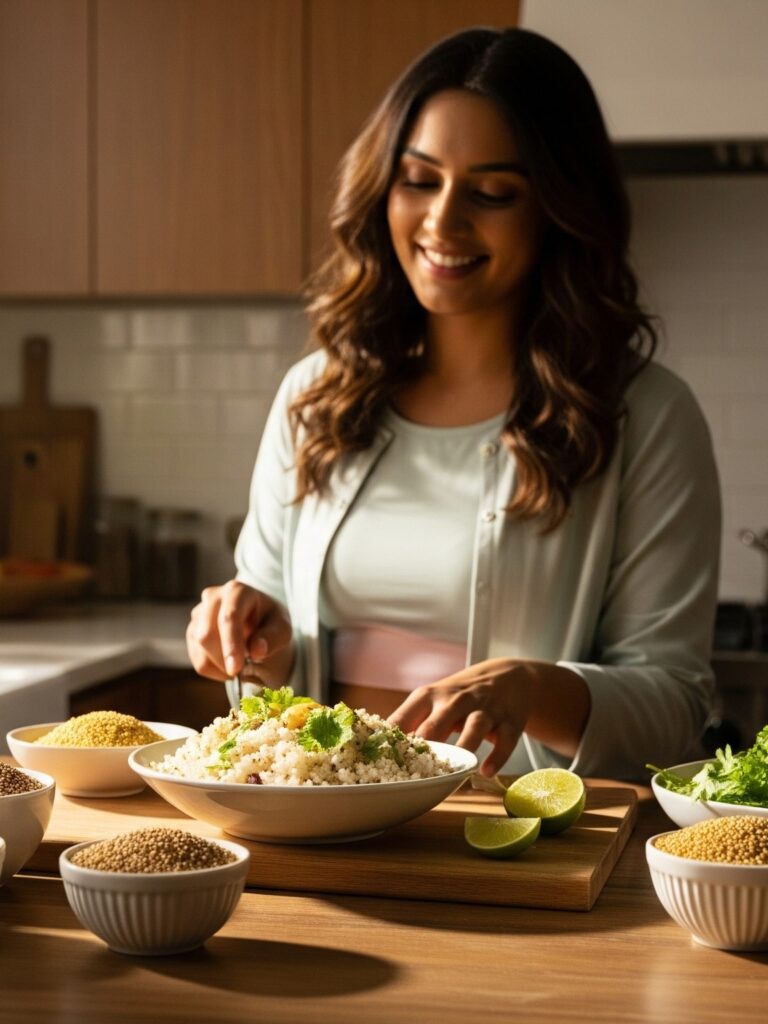Unlock the Power of Millets: Boost Metabolism and Lose Weight
Medically Reviewed By
Aditya Khurana (MD, MBBS)
In this blog
What is GLP-1 and how does it work?
Week-by-Week breakdown
Tips and lessons from real users
The EARLY Perspective
Conclusion
About the Author
References
Ready to lose weight for good?
Before Rice and Wheat took over Indian plates post-1960s, millets ruled the fields. Millets made up 40% of India’s crops. These nutrient-rich grains were the everyday staples until the Green Revolution.
But now the importance of Millets is being realized again. This began when the government of India declared 2018 as the “National Year of Millets”. Millets are being recognized not just in India but internationally. Recently, 2023 was celebrated as “ the International Year of Millets” by the United Nations.
The benefits of Millets range from supporting weight loss, managing sugar levels, to improving digestion. So if you are on a mission to lose weight, reduce belly fat, find tasty healthy alternatives to eat, or simply live a healthy lifestyle, this blog is for you. Let’s get to know why every nutritionist loves Millets and how you can include them in your diet to become a healthier you with expert guidance!
What Are Millets?
| Millet Name | Features |
| Foxtail millet (Kangni) | Light, easy to digest, rich in iron |
| Barnyard millet (Sanwa) | Low in carbs, ideal for diabetics |
| Finger millet (Ragi) | Calcium powerhouse, perfect for women and kids |
| Pearl millet (Bajra) | High in fiber, helps reduce cholesterol |
| Sorghum (Jowar) | Great source of protein and antioxidants |
| Little millet, Kodo millet, Proso millet | Lesser-known but equally nutritious options |
Millets VS Rice/Wheat:
| Feature | Rice/Wheat | Millets |
| Gluten | Contains gluten | They are gluten-free |
| Protein | ~6–9g per 100g | ~9–12g per 100g (Jowar, Ragi higher end) |
| Fiber | ~2–3g per 100g | ~8–12g per 100g |
| Calcium | ~10-30mg | ~25-350mg |
| Iron | ~1-3mg | ~4-8mg |
| Magnesium | ~20-30mg | ~80–120mg |
| Nutrient density | Medium nutrient density | Very high nutrient density |
What Are the Health Benefits of Millets?
- Pro-Digestion: Millets are super rich in fibre, and fibre supports gut health and ensures proper digestion. If you have bloating and constipation-like issues, millets are best for you.
- Diabetes friendly: Millets have a very low glycemic index, which means that they are good at regulating blood sugar levels, which makes them a safe choice for people who have diabetes.
- Weight Loss: Millets are very nutrient-dense, which means you get a lot of nutrients in a handful of millets. However, at the same time, millets are very low in calorie intake, which means that it is a perfect diet for people aiming to lose weight.
- Heart Health friendly: Some millets like Jowar and Bajra are very rich in magnesium and other antioxidants, which help to reduce cholesterol and also improve blood flow in the body and heart.
- Plant-Based Protein: If you are a vegetarian or a vegan, then this is a great source of protein, which keeps your muscles healthy.
- Calcium and Iron Rich: Millets have good amounts of iron, which helps in maintaining iron in hemoglobin and protects from diseases like anemia. In addition, it is also rich in calcium, which is very important for bone strength. This makes millets super important for women, children, and old-aged.
Millet-Based Menu for 1 Day
| Meal | Millet Dish |
| Breakfast | Ragi porridge with nuts & banana |
| Mid-morning | Buttermilk + roasted foxtail millet puff |
| Lunch | Jowar roti + dal + mixed veg sabzi |
| Snack | Millet khakhra or barnyard millet upma |
| Dinner | Bajra khichdi with sautéed greens |
Some Do’s and Don’ts with Millets:
| Dos | Don’ts |
| Do rotate different types of millets in your diet | Don’t overconsume because moderation is key |
| Do combine millets with dal, vegetables, and healthy fats | Don’t expect instant results, and give your body 2–3 weeks to adjust |
FAQs
- Is millet better than rice?
Yes! Millets are more nutrient-dense, gluten-free, and lower on the glycemic index compared to white rice. - Can I eat millets every day?
Yes, but remember that it’s best to rotate between different types of millets (mentioned above) and eat them in moderation. - Which millet is best for weight loss?
Foxtail millet, Barnyard millet, and Bajra are great for weight loss because they have high fiber and a low glycemic index. - Are millets gluten-free?
Yes, absolutely! All millets are naturally gluten-free, making them ideal for those with gluten intolerance or celiac disease. - What is the best time to eat Millets
Breakfast or lunch is the ideal time to eat Millets because one must avoid eating heavy meals at night in general.
Why Expert Guidance Matters?
While millets are amazing, not everyone sees results right away. Most people don’t understand why. Here are some reasons why:-
- Wrong portion sizes: People often either eat high amounts of Millets or very small portions.
- Imbalanced meals: People forget to balance Millets with healthy fats, vegetables, etc.
- Ignoring gut sensitivity: Some people don’t take into account their unique gut health and spoil their digestion by eating Millets in the wrong quantities or frequency.
- Eating millets at the wrong time: Often, people eat millets at the wrong time of day, which slows the digestion.
This is why it’s very important to have a consultation with an expert. An expert who will not only help you understand what diet to eat and how to cook these meals, but also help you develop the right way of lifestyle to become a healthy individual.
We have a surprise for you! We want to offer you a FREE 1-on-1 consultation with our expert health consultant who can help you build a balanced, sustainable diet that fits your body, schedule, and goals. We are also arranging an open, free-of-cost webinar where you can join us to know more about this free one-on-one appointment with our expert nutritionist!

About the Author
Dr. Geeta Chopra
Dr. Geeta Chopra is a former professor at Delhi University and advocate for the young and the most marginalized children. She spent almost four decades teaching, researching, and a policy advisor to GOI. She is also a lifelong sports person and fitness enthusiast who has deep dived into the world of fitness and the science behind it. She has authored six books, 25+ research papers and regularly writes thought pieces on topics that interest her.
References
- India Government Mint. n.d. “International Year of Millets 2023 (Denomination of `75) – Wooden Packing (PROOF) – FGCO001183 – India Government Mint.” Accessed June 5, 2025. https://www.indiagovtmint.in/en/product/international-year-of-millets-2023-denomination-of-75-wooden-packing-proof/.
- “Indian staple food market – statistics and facts.” 2023. Statista. https://www.statista.com/topics/5755/staple-food-market-in-india/#topicOverview.
- “MILLETS: The Future Food.” 2023. India Science, Technology & Innovation – ISTI Portal. https://www.indiascienceandtechnology.gov.in/listingpage/millets-future-food
- Walkikar, Shilpa S. 2023. “Staple Food In Various States of India.” Research Gate.
In this blog
What Are Millets?
What Are the Health Benefits of Millets?
Millet-Based Menu for 1 Day
Some Do’s and Don’ts with Millets:
FAQs
Why Expert Guidance Matters?




